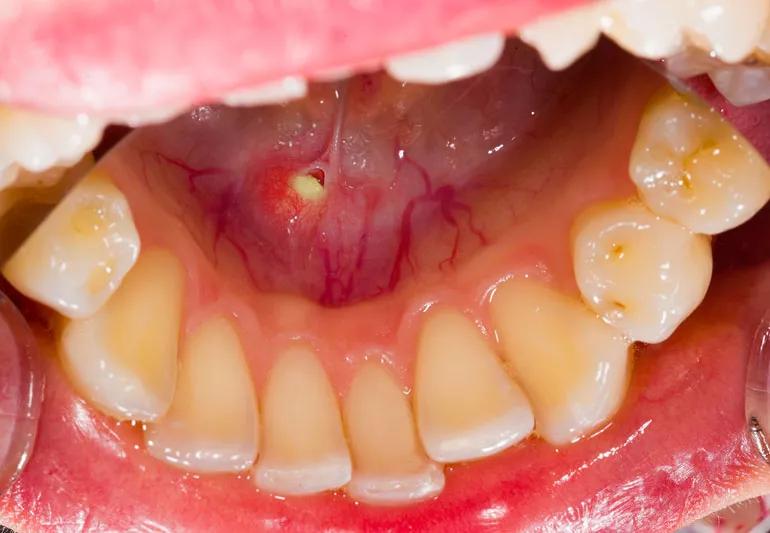Pain combined with a swollen salivary gland could indicate a stone

Pain in your mouth can make the joy of eating disappear — especially if the pain seems to worsen right as you’re about to eat.
Advertisement
Cleveland Clinic is a non-profit academic medical center. Advertising on our site helps support our mission. We do not endorse non-Cleveland Clinic products or services. Policy
If you’re experiencing this mysterious pain while you’re eating, this is the hallmark symptom of a salivary gland stone, or sialolithiasis. It’s not one of the more common causes of mouth pain, but it’s one that can be identified and usually treated successfully by someone who specializes in ear, nose and throat (ENT) issues.
ENT specialist Tony Reisman, MD, describes it as essentially a plumbing problem.
“A stone forms when salivary material mixes with a substance in the salivary glands and calcifies,” says Dr. Reisman. Learn more about how these stones develop and how to treat them, below.
Well, it’s not pleasant, to say the least.
The stone blocks one of the ducts that your saliva travels through to get from the gland (where it’s produced) to your mouth (where it’s needed to break down food and keep teeth strong), causing saliva to get backed up in the gland. The gland swells and can become infected and painful.
There are several glands on each side of your face that produce saliva. Salivary stones most often occur in or near the submandibular glands under the jaw, but they can also occur in the parotid glands on the sides of the jaw.
“Pain accompanied by a visibly swollen gland on the side of your face or under your jaw is the telltale sign of a salivary gland infection, and possibly a stone,” Dr. Reisman says.
Advertisement
The other thing is that you might be able to actually see a stone under the tongue or on the inside of the cheek. According to Dr. Reisman, stones have a whitish or yellowish color and can get as large as 2 centimeters in diameter.
They’re most likely to occur in:
“Salivary stones may be discovered by accident during a dental X-rays,” Dr. Reisman adds.
If a doctor is able to see the stone, they may be able to remove it in the office by giving you a local anesthesia and making a tiny incision over the stone.
If it’s not visible, a doctor will use a CT scan with contrast to locate it. If the stone is very deep, the doctor may want to remove it using a relatively new technique called salivary sialendoscopy.
“It’s done in the operating room, where you use a tiny scope to go through the actual duct in the floor of the mouth or the side of the cheek, and then there are baskets you can use to retrieve these stones,” Dr. Reisman says.
If the stone is very close to the gland, or stuck inside the gland, you might require surgery to remove the gland.
If you’re waiting to see your doctor, there are also home remedies you can try to lessen the pain of a salivary stone:
The good news is, while salivary stones can be painful, they aren’t usually a symptom of a bigger problem or disease. Try some home remedies to hold you over until you visit your doctor, and then go from there.
Dr. Reisman says, “For most patients, it’s one-and-done.”
Advertisement
Learn more about our editorial process.
Advertisement

Most recommended precautions center around minimizing bruising or swelling

Even one drink can have an impact on your cognitive function leading to slurred speech, blurred vision and impaired memory

Understand who may (and may not) benefit

Lorem ipsum dolor sit amet. Et odio Quis vel ipsam omnis eum alias deleniti et placeat impedit non voluptas galisum hic autem enim et cupiditate aliquid. Est beatae quidem non facilis autem ut commodi nisi aut tempore rerum et dolores voluptatem cum enim optio id sapiente quasi. Ad laboriosam officiis 33 cupiditate sequi ea voluptatum consectetur qui necessitatibus voluptate et quasi doloremque et facere explicabo quo explicabo officia

Seeking help through therapy can be an important step in improving your quality of life when you have UC

Type 2 diabetes isn’t inevitable with these dietary changes

Applying a hot or cold compress can help with pain